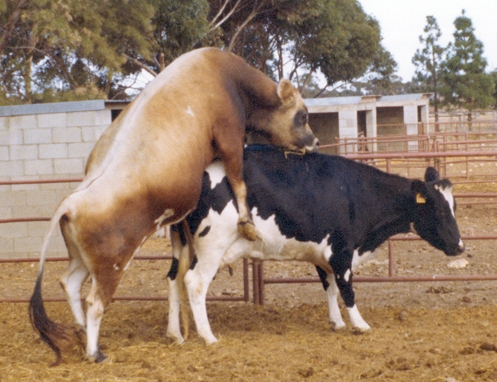
Bull serves cow. Using artificial insemination is cheaper than rearing a bull to serve cows. Photo by Agritech.tnau.in
Farmers rearing bulls to serve cows make loses of more than Sh30,000 per year in maintenance expenses, as oppose to those using artificial insemination.
Whilst the maintenance cost for the bull can surpass Sh30,000 per year, AI requires between Sh700 and Sh1,500 to serve a cow over the same period.
Nyamira County farmer Patrick Chuma says the space for the bull can be made productive by adding an extra cow that yields milk for about seven months before drying.
The farmer, who rears local breeds crossed with jersey, said rearing a bull for a single service per cow annually was a costly affair that he abandoned two years ago.
“The bull requires feeding for the rest of the year; it only serves the cow and takes a recess to feeding and fattening. I found this uneconomical as an upcoming dairy farmer,” the Nyankongo village farmers said.
The cost of AI service is about Sh1,500. With the subsidy from most county governments like Nyandarua, the cost has been reduced to between Sh700 and Sh1,000.
A bull requires feeds of about 10 kilos per day. It also requires vaccination, treatment, pest control sprays like ticks, mineral supplements like salt licks, among others.
Because of the excess energy after feeding well, the bull also causes damages to fences, and other structures if not well controlled.
READ ALSO:How bulls cause cow infertility
READ ALSO: Smart tool tells farmers cows are ripe for artificial insemination
READ ALSO: Artificial insemination in chicken boosts egg fertilization
It can also cause injuries to the farmer’s family and other cows.
“An account of the accruing costs of a bull for the entire year ranged from Sh30,000 to Sh40,000. That was way high given that AI for the three cows could have cost me a maximum of Sh4,500 per year, that if they were all on heat,” the farmer said.
Beside the treatment cost of bulls, they can also transmit diseases such as trichomoniasis, camphylobacteria, bovine herpes virus, ureaplasma, fibroids, among others.
Diseases like fibroids can cause infertility in cows.
“Since I started using AI, I am not worried of sexually transmitted diseases. Safety is also guaranteed with these rather docile cows, unlike the unruly bulls. The semen used in the AI is sourced from carefully selected bulls, screened before storage. There is no screening of the bull before serving a cow on heat. Sometimes the bull serves the cow before the farmer even realises,” Chuma said.
If the bull serves a cow in absence of the farmer, it may be tricky to keep accurate reproductive records, the farmer said.
Write comment (0 Comments)
















